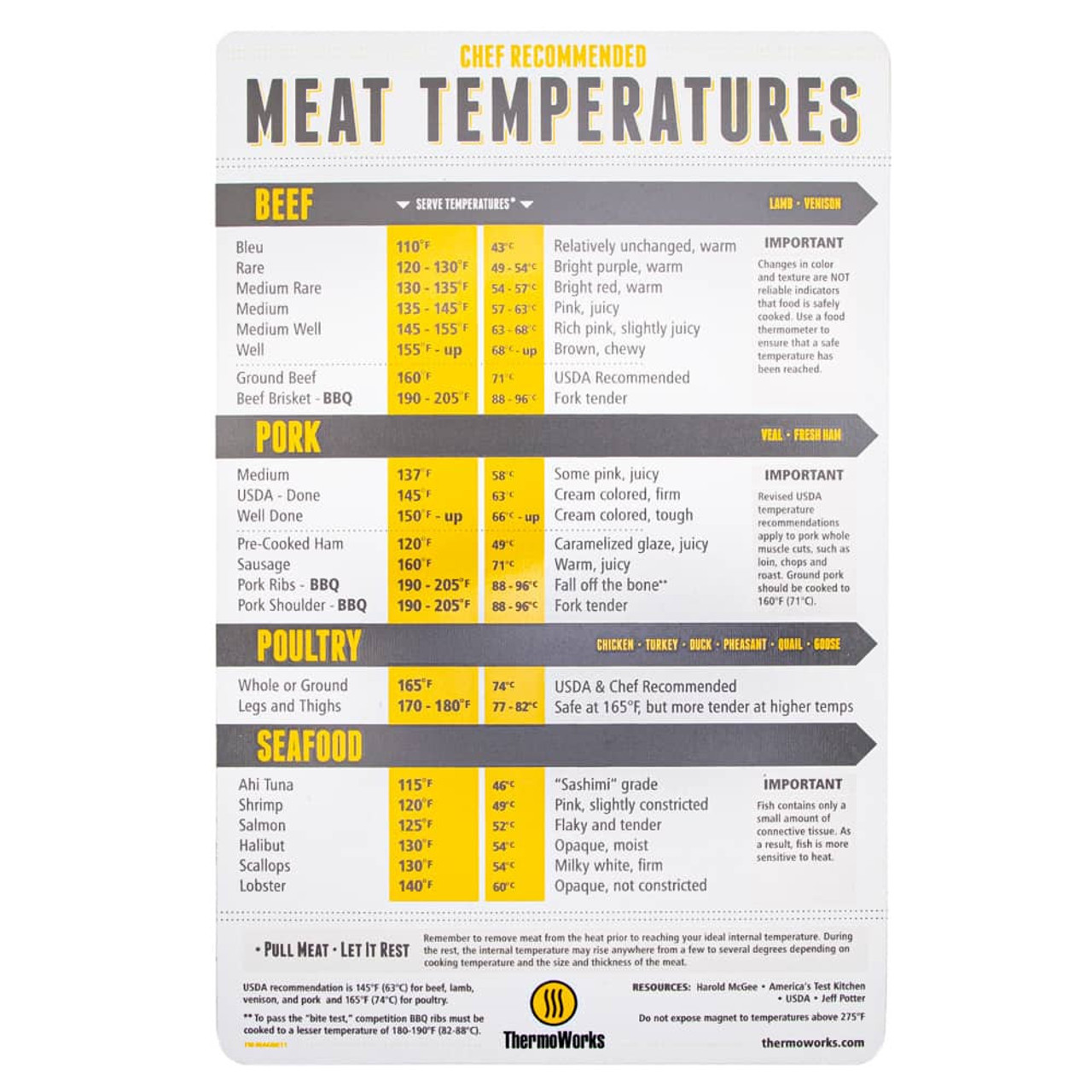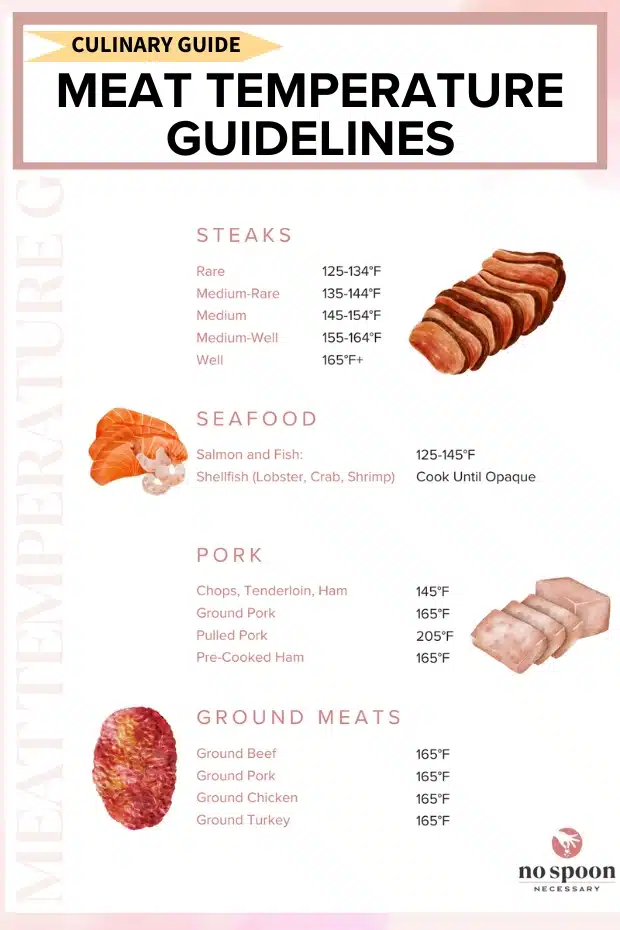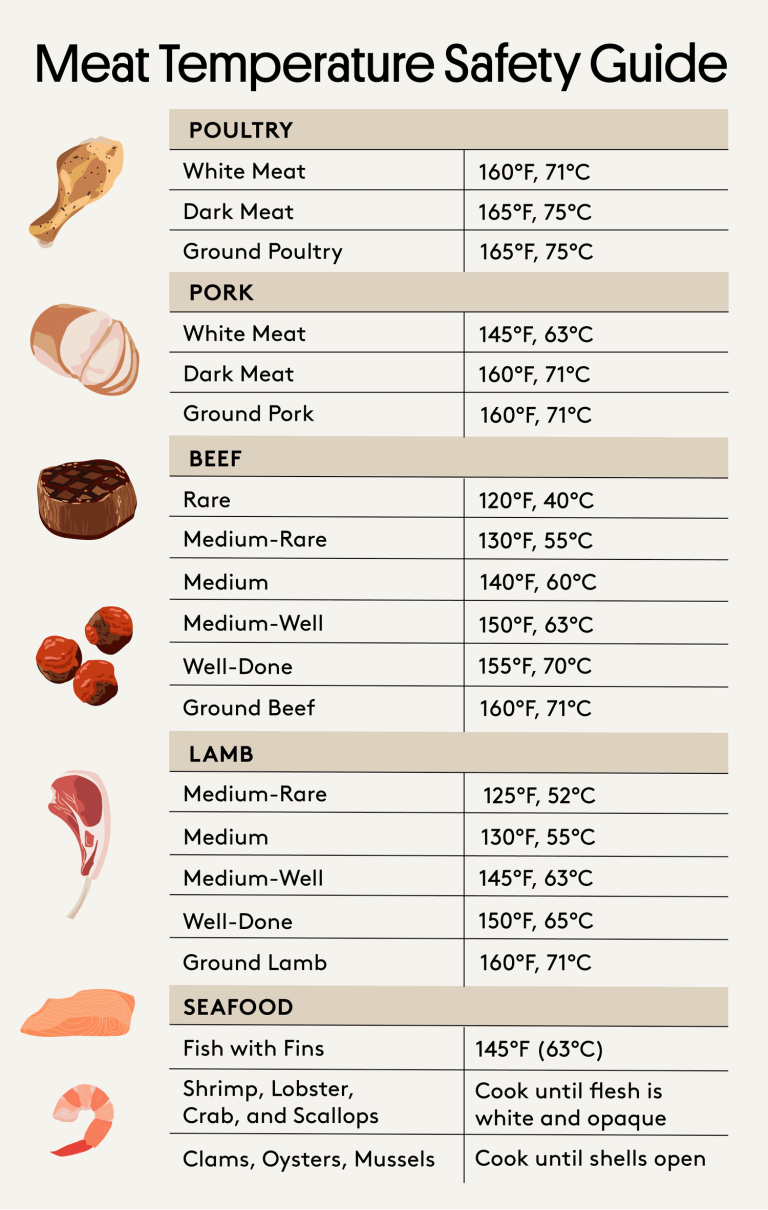Have you ever found yourself wondering if your steak is cooked just right or if your chicken is safe to eat? You’re not alone.
Cooking meat to the perfect temperature can seem like a daunting task, especially for beginners. But fear not; understanding meat temperatures doesn’t have to be complicated. Imagine serving a juicy, perfectly cooked roast at your next dinner party, impressing your friends and family with your newfound culinary skills.
With this guide, you’ll gain confidence in the kitchen, ensuring your meat is both delicious and safe to eat. Dive into this essential meat temperature guide, and transform your cooking experience from stressful guesswork to satisfying precision. Your taste buds will thank you!

Credit: www.amazon.com
Importance Of Meat Temperature
Cooking meat to the right temperature isn’t just about following recipes. It’s about ensuring safety and enhancing the flavors you savor. Understanding meat temperature can transform an average dish into a delightful experience. Whether you’re grilling, roasting, or frying, knowing the importance of meat temperature is crucial for any beginner cook. Let’s dive into why meat temperature matters and how it can make your culinary adventures safer and tastier.
Safety Considerations
Getting the temperature right is paramount for safety. Eating undercooked meat can lead to foodborne illnesses, which can be severe. Using a meat thermometer helps you avoid these risks, giving you peace of mind at the dinner table.
Think about the last time you had a barbecue. It’s easy to get caught up in the fun and forget about cooking safety. Checking the meat’s temperature ensures you’re serving a safe meal to your friends and family.
It’s not just about avoiding illness. Properly cooked meat doesn’t have to be dry or tough. It can be juicy, tender, and safe all at once.
Impact On Flavor And Texture
Temperature affects more than just safety; it significantly impacts flavor and texture. Cooking meat to the right temperature brings out its natural flavors. This can turn a simple steak into a mouth-watering dish.
Imagine biting into a perfectly cooked chicken breast. It’s juicy, tender, and bursting with flavor because it was cooked at just the right temperature. That’s the magic of understanding meat temperature.
Temperature also affects the meat’s texture. Overcooked meat can be chewy and dry, while undercooked meat can be tough and unappetizing. Finding the sweet spot is key to a delicious meal.
Do you remember a meal that was less than perfect because the meat was either too dry or too tough? That’s a temperature issue. Mastering meat temperature means mastering flavor and texture.

Credit: www.thermoworks.com
Essential Tools For Measuring Temperature
Digital thermometers are essential for beginners learning to cook meat. They provide accurate readings quickly. Knowing the right temperature ensures meat is safe and tasty. Oven-safe thermometers are great for slow roasting. Instant-read thermometers work well for quick checks. Proper tools make cooking easier and more enjoyable.
Cooking meat to the perfect temperature can transform your meal from just okay to absolutely delicious. If you’re a beginner, knowing the right tools to measure meat temperature can be a game-changer in your cooking journey. With the right thermometer, you can ensure your meats are cooked safely and taste their best. But what types of thermometers should you consider, and how do you use them effectively? Let’s dive in.Types Of Thermometers
Choosing the right thermometer can feel overwhelming with so many options available. Digital instant-read thermometers are a popular choice. They provide quick and accurate readings, usually within seconds, making them perfect for busy cooking sessions. Dial thermometers might take a bit longer to give a reading, but they are durable and don’t require batteries. Some cooks swear by their reliability. On the higher end, infrared thermometers offer a no-contact way to measure surface temperatures, although they might not be the best for internal meat temperatures. Leave-in thermometers can be inserted into the meat before cooking. These are fantastic for roasts and larger cuts, as they monitor the temperature throughout the cooking process.How To Use A Meat Thermometer
Using a meat thermometer isn’t just about sticking it into the meat. Proper technique ensures accuracy. Insert the thermometer into the thickest part of the meat, avoiding bones and fat, for the most accurate reading. For thin cuts, like chicken breasts, insert the thermometer sideways. This approach helps get a consistent reading across the cut. Remember to clean your thermometer after each use. It might seem obvious, but it’s a crucial step in preventing cross-contamination. Keep it handy, so you can check the temperature multiple times as your dish cooks. Have you ever overcooked a steak because you guessed the temperature? With the right thermometer, those days are behind you. A small investment in a good thermometer can elevate your cooking from guesswork to precision. What type of thermometer will you choose for your next culinary adventure?Temperature Guide For Different Meats
Understanding the right temperature for cooking meat ensures safety and enhances flavor. Beginners can benefit from a simple guide that highlights ideal cooking temperatures for various meats, such as beef, chicken, and fish. Proper temperature helps achieve juicy and tender results, making meals both safe and delicious.
Understanding the right temperature for cooking different meats is crucial for both flavor and safety. Whether you’re a novice cook or looking to up your grilling game, knowing the correct temperatures can make all the difference. Properly cooked meat not only tastes better but also ensures you avoid any health risks. Let’s dive into a beginner-friendly temperature guide for various meats. ###Beef And Lamb
Cooking beef and lamb to the right temperature is essential for achieving your preferred doneness. For a juicy medium-rare steak, aim for an internal temperature of 130-135°F (54-57°C). If you prefer your steak medium, 135-145°F (57-63°C) is your target range. Lamb follows a similar guide. A medium-rare lamb chop should be cooked to 135°F (57°C). Have you ever bitten into a perfectly cooked lamb chop and felt the tenderness melt in your mouth? That’s the magic of hitting the right temperature. ###Pork
Pork has come a long way from the overcooked, dry dishes of the past. Current guidelines suggest cooking pork to an internal temperature of 145°F (63°C) for a moist and flavorful result. This applies to cuts like pork loin or tenderloin. Ground pork, however, should reach 160°F (71°C) to ensure safety. Trust me, once you taste pork cooked to these temperatures, you’ll never look back. You’ll wonder why you ever settled for anything less. ###Poultry
Poultry needs to be cooked thoroughly to avoid any health issues. Chicken and turkey should reach an internal temperature of 165°F (74°C). Have you ever cut into a piece of chicken and found it undercooked? It’s not only unappetizing but potentially dangerous. Make sure to check the thickest part of the poultry, such as the breast or thigh. You’ll thank yourself for investing in a good meat thermometer—it’s your best friend in the kitchen. ###Fish And Seafood
Cooking fish and seafood requires a gentle touch and precise timing. Most fish are perfect when cooked to an internal temperature of 145°F (63°C). Have you ever overcooked a piece of salmon, turning it dry and unappealing? For shellfish like shrimp, the flesh should turn opaque and firm. Watching that transformation and knowing you nailed the texture can be incredibly rewarding. Remember, fish continues to cook after being removed from heat, so check early and often. Getting the temperature right isn’t just about safety; it’s about enhancing the natural flavors of each meat. Have you been overlooking this crucial step in your cooking routine? If so, it’s time to make a change and elevate your meals.Cooking Techniques For Perfect Temperature
Cooking meat to the right temperature ensures both flavor and safety. Beginners often struggle with achieving the perfect doneness. Using the right techniques makes this task easier. Below, we explore three popular methods. Each method helps in achieving the ideal meat temperature.
Grilling Tips
Grilling offers a smoky flavor to meats. Preheat your grill before placing the meat. This helps in even cooking. Use a meat thermometer to check the temperature. Flip the meat only once during grilling. Let the meat rest after removing it from the grill. This helps in retaining the juices.
Oven Cooking
Oven cooking provides a controlled environment. Preheat the oven to the desired temperature. Place the meat on a baking sheet or in a roasting pan. Use an oven thermometer for accuracy. Cook the meat until it reaches the desired internal temperature. Let it rest for a few minutes before serving.
Sous Vide Method
Sous vide involves cooking meat in a water bath. The meat is sealed in a plastic bag. Set the water to the exact temperature you want. This method ensures precise cooking. The meat remains tender and juicy. Finish by searing the meat in a hot pan for texture.
Common Mistakes To Avoid
Cooking meat to perfection requires skill and patience. Beginners often make mistakes that can ruin the dish. Understanding these errors is crucial. This guide helps you avoid common pitfalls.
Overcooking
Overcooking meat dries it out. It loses flavor and texture. Many cooks worry about undercooking and go too far. Use a thermometer to ensure accuracy.
Undercooking
Undercooking is risky. It can lead to health issues. Raw meat may harbor bacteria. Always check internal temperatures. Follow recommended guidelines for safe cooking.
Inaccurate Temperature Reading
Inaccurate readings cause problems. Use a reliable meat thermometer. Calibrate it regularly. Avoid guessing with the touch test. Precise measurements are key to cooking success.
Tips For Achieving Ideal Meat Temperature
Achieving the perfect meat temperature is key to delicious and safe meals. Whether you’re grilling a steak or roasting a chicken, understanding how to get your meat to its ideal temperature can transform your cooking. Are you ready to elevate your culinary skills?
Resting Meat
Resting meat is a game-changer. Allowing your meat to rest after cooking lets the juices redistribute. This simple step makes every bite juicy and flavorful. It might be tempting to dive right in, but patience pays off. Have you ever cut into a steak only to see a pool of juice escape onto your plate? That’s the magic of resting.
Using Marinades And Rubs
Marinades and rubs do more than add flavor—they can impact cooking time and temperature. Marinades tenderize meat and can make it cook faster. Rubs often create a crust that seals in juices and heat. Experiment with different combinations to find what works best for your taste. Have you tried a spicy rub on chicken or a herb marinade on beef? The possibilities are endless!
Adjusting Cooking Times
Cooking times vary based on meat thickness and type. Thin cuts require less time than thick ones. Always use a meat thermometer to ensure accuracy. If your meat is not at the desired temperature, adjust your cooking time accordingly. Remember, overcooked meat can be tough and dry, while undercooked meat can be unsafe. Have you ever found yourself adjusting the oven or grill based on how your meat looks? Trust your instincts and your thermometer.
Achieving the ideal meat temperature isn’t just about following a recipe. It’s about understanding your ingredients and tools. The next time you cook, remember these tips and enjoy a perfectly cooked meal! What’s your go-to method for ensuring perfect meat temperature? Share your tips and tricks below!

Credit: www.nospoonnecessary.com
Frequently Asked Questions
What Are The Correct Temperatures For All Meats?
Cook beef, pork, lamb, and veal steaks to 145°F. Ground meats should reach 160°F. Poultry needs 165°F. Fish is safe at 145°F.
What Is The Usda Rule For Meat Temperatures?
The USDA recommends cooking beef, pork, veal, and lamb to 145°F with a three-minute rest. Cook ground meats to 160°F. Poultry should reach 165°F. Use a food thermometer for accuracy.
What Is The Standard Temperature For Meat?
The standard temperature for cooking meat varies. Poultry should reach 165°F (74°C), ground meats 160°F (71°C), and steaks or roasts 145°F (63°C) with a rest time. Proper cooking ensures safety and flavor. Always use a meat thermometer to check the temperature accurately.
How To Use A Meat Thermometer Correctly?
Insert the thermometer into the thickest part of the meat, avoiding bones or fat. Ensure it stays in until stable. Check the temperature against the recommended safe cooking guidelines. Clean the thermometer after each use to prevent cross-contamination. Use a digital or dial thermometer for precise readings.
Conclusion
Understanding meat temperatures is key for safe and tasty meals. Always use a reliable thermometer. This ensures your meat cooks perfectly. Remember, each type has its own ideal temperature. Chicken, beef, and pork all differ. Practice makes perfect. Over time, you’ll get the hang of it.
Keep learning and exploring new recipes. This guide is just the beginning. Cooking is fun and rewarding. Share your dishes with family and friends. They will appreciate your effort. Enjoy the journey of cooking delicious meat dishes. Stay safe and happy cooking!


